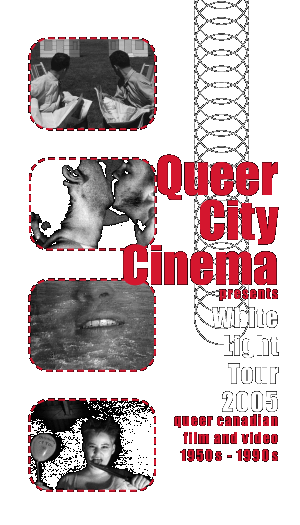








Welcome Back
...Welcome way back.
As you will discover, there is a theme that dominates this year's tour - history. From the initially controversial and Academy Award winning efforts of Norman Mclaren at the NFB, to the various 'rights' movements, the AIDS crisis, and on to identity politics and in your face sexuality, the White Light guest curated series of films and videos from the 1940's to 1990's take us on a journey through time, place, circumstance, and situation.
Sure, the context is 'history', but the subjects, ideas, politics, and perspectives of many of the films and videos that make up this year's tour are timeless and relevant, and remind us how powerful and revealing the moving image has been and continues to be for both queer artists and audiences, and how the bigger picture of what we call queer and popular culture has absorbed it all.
As the title of the tour evokes, this White Light was artists exposing the varied landscapes of queer artistic experimentation, and the personal which was and became so very political and critical in bringing about social change and awareness.
This shining of the light on brave new ideas and aesthetics, and on issues political, fostered the first film festivals some 30 years ago. The explosion of festivals worldwide in the late 80's and early 90's is a testament to not only the popularity of queer film and video, but to the universality of the subjects and ideas found within them. At one point, most of us were able to find and see ourselves on a screen and, perhaps more importantly, to discover new ways of seeing the world around us.
Speaking of festivals in the context of time, as I went about planning for last year's installment of Queer City Cinema - and subsequently this tour - I was inevitably drawn towards my own history with queer film and video, namely the first Queer City Cinema in 1996, which was preceded by research and travel to festivals and distribution centres across Canada and the USA. Those 'virgin days' were intensely, profoundly and both figuratively and literally eye opening. Not only was I experiencing for the first time the thrill of queer collective viewing with hundreds and sometimes thousands of eager viewers (let's just say the task of finding a seat in a packed hall was not unpleasant) I also met many artists, programmers, organizers, and distributors who have contributed, in fundamental ways, to the evolution of both my 'self' and Queer City Cinema.
Thus, the four individuals who were invited to guest curate for the this year's tour have been met along my fairy way, have been part of recent and past Queer City Cinema Festivals in one form or another, and are contributing once more through their personal and impassioned selection of films and videos. As their programs trickled in, I was struck with how their own histories and experience engendered their selections. I suppose when one is dealing with ideas related to the delineation of time you not only take a look at the work, you take a look at yourself as well.
Ultimately, taking another look is what this tour is all about. The position of queer image making and watching has certainly evolved or, one might argue, regressed in the past several years. Admittedly, this current state of affairs in queer image making played a major part in my reasons for doing this about face and retreating to the programming of historical works. As the production of feature length endeavours continue to become more prolific, popular, and with that, a commodity of sorts, the landscape of queer festival programming has changed and continues to do so. A welcome development for some, yet a growing concern for others as, I believe, the occurrence of artistically rigorous and personal works has diminished. The obvious questions emerge - have we sold out?, or is this an indication of progress or a pleasurable consequence of our 'movement'? But in which direction are we going? As always, time will tell.
In the meantime, along with the rare opportunity to look, listen, and learn, I would like to suggest that perhaps we take the time to retrace our proud steps back to a place where cinema truly looked queer to the eye and spoke deeply to the soul.
Gary Varro
Artistic Director
May 2005